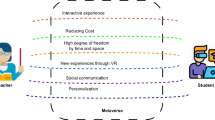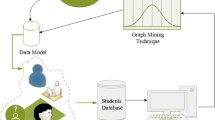Abstract
Students learning performance prediction is a challenging task due to the dynamic, virtual environments and the personalized needs for different individuals. To ensure that learners’ potential problems can be identified as early as possible, this paper aim to develop a predictive model for effective learning feature extracting, learning performance predicting and result reasoning. We first proposed a general learning feature quantification method to convert the raw data from e-learning systems into sets of independent learning features. Then, a weighted avg-pooling is chosen instead of typical max-pooling in a novel convolutional GRU network for learning performance prediction. Finally, an improved parallel xNN is provided to explain the prediction results. The relevance of positive/negative between features and result could help students find out which part should be improved. Experiments have been carried out over two real online courses data. Results show that our proposed approach performs favorably compared with several other state-of-the-art methods.






Similar content being viewed by others
References
Ballas N, Yao L, Pal C, Courville A (2015) Delving deeper into convolutional networks for learning video representations. ArXiv preprint arXiv:1511.06432
Binh HT, Duy BT (2017) Predicting students’ performance based on learning style by using artificial neural networks. In: Proceedings of the 9th International Conference on Knowledge and Systems Engineering (KSE), IEEE , pp 48–53
Boureau YL, Bach F, Lecun Y, Ponce J (2010) Learning mid-level features for recognition. In: Proceedings of the 27th computer vision and pattern recognition, IEEE, pp 2559–2566
Burgos C, Campanario ML, Peña D, Lara JA, Lizcano D, Martnez MA (2018) Data mining for modeling students performance: a tutoring action plan to prevent academic dropout. Comput Electr Eng 66:541–556
Chung J, Gulcehre C, Cho K, Bengio Y (2014) Empirical evaluation of gated recurrent neural networks on sequence modeling. ArXiv preprint arXiv:1412.3555
Fok WW, He Y, Yeung HA, Law K, Cheung K, Ai Y, Ho P (2018) Prediction model for students’ future development by deep learning and tensorflow artificial intelligence engine. In: Proceedings of the 4th international conference on information management (ICIM), IEEE, pp 103–106
Gardner J, Brooks C (2018) Student success prediction in MOOCs. User Model User Adapt Interact 28(2):127–203
He K, Zhang X, Ren S, Sun J (2015) Delving deep into rectifiers: surpassing human-level performance on imagenet classification. In: Proceedings of the international conference on computer vision (ICCV), IEEE, pp 1026–1034
Hermans M, Schrauwen B (2013) Training and analysing deep recurrent neural networks. In: Proceedings of the 26th advances in neural information processing systems (NIPS), pp 190–198
Hilbert M (2016) Big data for development: a review of promises and challenges. Dev Policy Rev 34(1):135–174
Hinton GE, Srivastava N, Krizhevsky A, Sutskever I, Salakhutdinov RR (2012) Improving neural networks by preventing co-adaptation of feature detectors. ArXiv preprint arXiv:1207.0580
Holmes M, Latham A, Crockett K, O’Shea JD (2018) Near real-time comprehension classification with artificial neural networks: decoding e-learner non-verbal behavior. IEEE Trans Learn Technol 11(1):5–12
Huang C, Yang S, Pan Y, Lai H (2018) Object-location-aware hashing for multi-label image retrieval via automatic mask learning. IEEE Trans Image Process 27(9):4490–4502
Huang C, Xu H, Xie L, Zhu J, Xu C, Tang Y (2018) Large-scale semantic web image retrieval using bimodal deep learning techniques. Inf Sci 430:331–348
Hughes G, Dobbins C (2015) The utilization of data analysis techniques in predicting student performance in massive open online courses (MOOCs). Res Pract Technol Enhanc Learn 10(10):1–18
Ioffe S, Szegedy C (2015) Batch normalization: Accelerating deep network training by reducing internal covariate shift. ArXiv preprint arXiv:1502.03167
Kingma DP, Ba J (2014) Adam: a method for stochastic optimization. ArXiv preprint arXiv:1412.6980
Lin M, Chen Q, Yan S (2013) Network in network. ArXiv preprint arXiv:1312.4400
Moridis CN, Economides AA (2009) Prediction of students mood during an online test using formula-based and neural network-based method. Comput Educ 53(3):644–652
Nam S, Frishkoff G, Thompson K (2018) Predicting students disengaged behaviors in an online meaning-generation task. IEEE Trans Learn Technol 11(3):362–375
Ognjanovic I, Gasevic D, Dawson S (2016) Using institutional data to predict student course selections in higher education. Internet High Educ 29:49–62
Ramezani M, Jahanshahi M (2017) Load-aware multicast routing in multi-radio wireless mesh networks using FCA-CMAC neural network. Computing 100:473–501
Rathore SS, Kumar S (2017) A decision tree logic based recommendation system to select software fault prediction techniques. Computing 99(3):255–285
Ruan L, Yuan M (2010) Dimension reduction and parameter estimation for additive index models. Stat Interface 3(4):493–499
Shahiri AM, Husain W (2015) A review on predicting student’s performance using data mining techniques. Proc Comput Sci 72:414–422
Tang H, Xing W, Pei B (2018) Exploring the temporal dimension of forum participation in MOOCs. Distance Educ 39(3):1–20
Vaughan J, Sudjianto A, Brahimi E, Chen J, Nair VN (2018) Explainable neural networks based on additive index models. ArXiv preprint arXiv:1806.01933
Vitiello M, Walk S, Helic D, Chang V, Guetl C (2018) User behavioral patterns and early dropouts detection: improved users profiling through analysis of successive offering of MOOC. J Univ Comput Sci 24(8):1131–1150
Wang X, Huang C, Zhu J, Xu X (2018) Study on learning condition prediction based on big data analysis in cloud learning space. e-Educ Res 39(10):63–70
Wang X, Jiang W, Luo Z (2016) Combination of convolutional and recurrent neural network for sentiment analysis of short texts. In: Proceedings of the 26th international conference on computational linguistics (COLING 2016), pp 2428–2437
Yang TY, Brinton CG, Wong C, Chiang M (2017) Behavior-based grade prediction for MOOCs via time series neural networks. IEEE J Sel Top Signal Process 11(5):716–728
You JW (2016) Identifying significant indicators using LMS data to predict course achievement in online learning. Internet Higher Educ 29:23–30
Zhang Z, Robinson D, Tepper J (2018) Detecting hate speech on twitter using a convolution-GRU based deep neural network. In: Proceedings of the 15th European semantic web conference (ESWC2018), Springer, pp 745-760
Author information
Authors and Affiliations
Corresponding author
Additional information
Publisher's Note
Springer Nature remains neutral with regard to jurisdictional claims in published maps and institutional affiliations.
This work was supported by the National Natural Science Foundation of China (Nos. 61877020 and 61802132), the China Postdoctoral Science Foundation (No. 2018M630959), the S&T Project of Guangdong Province (No. 2016B010109008), and the S&T Project of Guangzhou Municipality, China (No. 201604016019).
Rights and permissions
About this article
Cite this article
Wang, X., Wu, P., Liu, G. et al. Learning performance prediction via convolutional GRU and explainable neural networks in e-learning environments. Computing 101, 587–604 (2019). https://doi.org/10.1007/s00607-018-00699-9
Received:
Accepted:
Published:
Issue Date:
DOI: https://doi.org/10.1007/s00607-018-00699-9
Keywords
- Learning performance prediction
- Learning feature quantification
- Deep neural network
- E-learning environments




